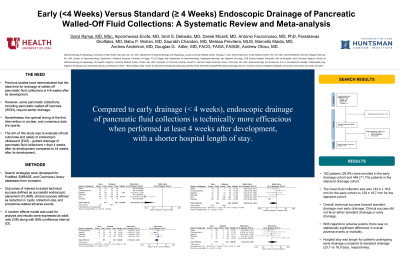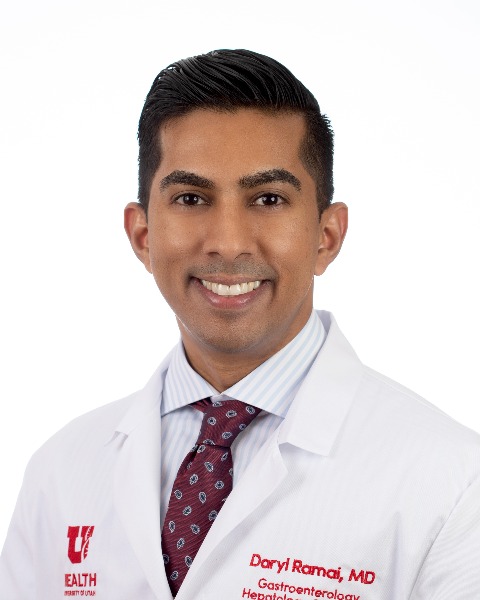Back


Poster Session D - Tuesday Morning
Category: Interventional Endoscopy
D0433 - Early (<4 Weeks) vs Standard (≥ 4 Weeks) Endoscopic Drainage of Pancreatic Walled-Off Fluid Collections: A Systematic Review and Meta-Analysis
Tuesday, October 25, 2022
10:00 AM – 12:00 PM ET
Location: Crown Ballroom

Has Audio

Daryl Ramai, MD, MSc
University of Utah
Salt Lake City, UT
Presenting Author(s)
Award: Presidential Poster Award
Daryl Ramai, MD, MSc1, Smit Deliwala, MD2, Ikponmwosa Enofe, MD3, Daniel Mozell, MD4, Antonio Facciorusso, MD, PhD5, Marcello Maida, MD6, Douglas G. Adler, MD, FACG7, Andrew Ofosu, MD, MPH8
1University of Utah, Salt Lake City, UT; 2Michigan State University at Hurley Medical Center, Flint, MI; 3Loyola University Medical Center, Chicago, IL; 4Elmhurst Hospital, Elmhurst, NY; 5University of Foggia, Foggia, Puglia, Italy; 6S. Elia-Raimondi Hospital, Caltanissetta, Sicilia, Italy; 7Centura Health-Porter Adventist Hospital, Salt Lake City, UT; 8University of Cincinnati, Cincinnati, OH
Introduction: Previous studies have demonstrated that the ideal time for drainage of walled off pancreatic fluid collections is 4-6 weeks after its development. However, some pancreatic collections, including pancreatic walled-off necrosis (WON), require earlier drainage. Nevertheless, the optimal timing of the first intervention is unclear, and consensus data are sparse. The aim of this study was to evaluate clinical outcomes and safety of endoscopic ultrasound (EUS) - guided drainage of pancreatic fluid collections < than 4 weeks after its development compared to ≥4 weeks after its development.
Methods: Search strategies were developed for PubMed, EMBASE, and Cochrane Library databases from inception through June 2022 in accordance with PRISMA and MOOSE guidelines. Outcomes of interest included technical success defined as successful endoscopic placement of LAMS, clinical success defined as reduction in cystic collection size, and procedure-related adverse events. A random effects model was used for analysis and results were expressed as odds ratio (OR) along with 95% confidence interval (CI).
Results: A total of 6 studies (630 patients) were included in our final analysis where 182 patients (28.9%) were enrolled in the early drainage cohort and 448 (71.1%) patients in the standard drainage cohort. Age ranges were similar between groups. Alcohol was the main driver of acute pancreatitis. Infection was the most common indication for pancreatic drainage (42.6%). The mean fluid collection size was 143.4 ± 18.8 mm for the early cohort vs 128 ± 19.7 mm for the standard cohort. Most fluid collections were located in the body of the pancreas (86.7%). Overall, technical success favored standard drainage over early drainage (OR 0.01; 95% CI 0.00 – 0.15; P=0.001). Clinical success also favored standard drainage over early drainage (OR 0.46; 95% CI 0.16 – 1.32; P=0.03). With regards to adverse events, there was no statistically significant difference in overall adverse events (OR 0.76; 95% CI 0.42 – 1.39; P=0.56) or mortality (OR 1.14; 95% CI 0.29 – 4.48; P=0.23). Hospital stay was longer for patients undergoing early drainage compared to standard drainage (23.7 vs 16.0 days, respectively).
Discussion: Compared to early drainage (< 4 weeks), endoscopic drainage of pancreatic fluid collections is significantly more efficacious when performed at least 4 weeks after development, with a shorter hospital length of stay. Therefore, pancreatic fluid collections should ideally be drained 4 weeks after development.

Disclosures:
Daryl Ramai, MD, MSc1, Smit Deliwala, MD2, Ikponmwosa Enofe, MD3, Daniel Mozell, MD4, Antonio Facciorusso, MD, PhD5, Marcello Maida, MD6, Douglas G. Adler, MD, FACG7, Andrew Ofosu, MD, MPH8. D0433 - Early (<4 Weeks) vs Standard (≥ 4 Weeks) Endoscopic Drainage of Pancreatic Walled-Off Fluid Collections: A Systematic Review and Meta-Analysis, ACG 2022 Annual Scientific Meeting Abstracts. Charlotte, NC: American College of Gastroenterology.
Daryl Ramai, MD, MSc1, Smit Deliwala, MD2, Ikponmwosa Enofe, MD3, Daniel Mozell, MD4, Antonio Facciorusso, MD, PhD5, Marcello Maida, MD6, Douglas G. Adler, MD, FACG7, Andrew Ofosu, MD, MPH8
1University of Utah, Salt Lake City, UT; 2Michigan State University at Hurley Medical Center, Flint, MI; 3Loyola University Medical Center, Chicago, IL; 4Elmhurst Hospital, Elmhurst, NY; 5University of Foggia, Foggia, Puglia, Italy; 6S. Elia-Raimondi Hospital, Caltanissetta, Sicilia, Italy; 7Centura Health-Porter Adventist Hospital, Salt Lake City, UT; 8University of Cincinnati, Cincinnati, OH
Introduction: Previous studies have demonstrated that the ideal time for drainage of walled off pancreatic fluid collections is 4-6 weeks after its development. However, some pancreatic collections, including pancreatic walled-off necrosis (WON), require earlier drainage. Nevertheless, the optimal timing of the first intervention is unclear, and consensus data are sparse. The aim of this study was to evaluate clinical outcomes and safety of endoscopic ultrasound (EUS) - guided drainage of pancreatic fluid collections < than 4 weeks after its development compared to ≥4 weeks after its development.
Methods: Search strategies were developed for PubMed, EMBASE, and Cochrane Library databases from inception through June 2022 in accordance with PRISMA and MOOSE guidelines. Outcomes of interest included technical success defined as successful endoscopic placement of LAMS, clinical success defined as reduction in cystic collection size, and procedure-related adverse events. A random effects model was used for analysis and results were expressed as odds ratio (OR) along with 95% confidence interval (CI).
Results: A total of 6 studies (630 patients) were included in our final analysis where 182 patients (28.9%) were enrolled in the early drainage cohort and 448 (71.1%) patients in the standard drainage cohort. Age ranges were similar between groups. Alcohol was the main driver of acute pancreatitis. Infection was the most common indication for pancreatic drainage (42.6%). The mean fluid collection size was 143.4 ± 18.8 mm for the early cohort vs 128 ± 19.7 mm for the standard cohort. Most fluid collections were located in the body of the pancreas (86.7%). Overall, technical success favored standard drainage over early drainage (OR 0.01; 95% CI 0.00 – 0.15; P=0.001). Clinical success also favored standard drainage over early drainage (OR 0.46; 95% CI 0.16 – 1.32; P=0.03). With regards to adverse events, there was no statistically significant difference in overall adverse events (OR 0.76; 95% CI 0.42 – 1.39; P=0.56) or mortality (OR 1.14; 95% CI 0.29 – 4.48; P=0.23). Hospital stay was longer for patients undergoing early drainage compared to standard drainage (23.7 vs 16.0 days, respectively).
Discussion: Compared to early drainage (< 4 weeks), endoscopic drainage of pancreatic fluid collections is significantly more efficacious when performed at least 4 weeks after development, with a shorter hospital length of stay. Therefore, pancreatic fluid collections should ideally be drained 4 weeks after development.

Figure: Forrest plot showing pooled rates of clinical success
Disclosures:
Daryl Ramai indicated no relevant financial relationships.
Smit Deliwala indicated no relevant financial relationships.
Ikponmwosa Enofe indicated no relevant financial relationships.
Daniel Mozell indicated no relevant financial relationships.
Antonio Facciorusso indicated no relevant financial relationships.
Marcello Maida indicated no relevant financial relationships.
Douglas Adler: Boston Scientific – Consultant.
Andrew Ofosu indicated no relevant financial relationships.
Daryl Ramai, MD, MSc1, Smit Deliwala, MD2, Ikponmwosa Enofe, MD3, Daniel Mozell, MD4, Antonio Facciorusso, MD, PhD5, Marcello Maida, MD6, Douglas G. Adler, MD, FACG7, Andrew Ofosu, MD, MPH8. D0433 - Early (<4 Weeks) vs Standard (≥ 4 Weeks) Endoscopic Drainage of Pancreatic Walled-Off Fluid Collections: A Systematic Review and Meta-Analysis, ACG 2022 Annual Scientific Meeting Abstracts. Charlotte, NC: American College of Gastroenterology.

